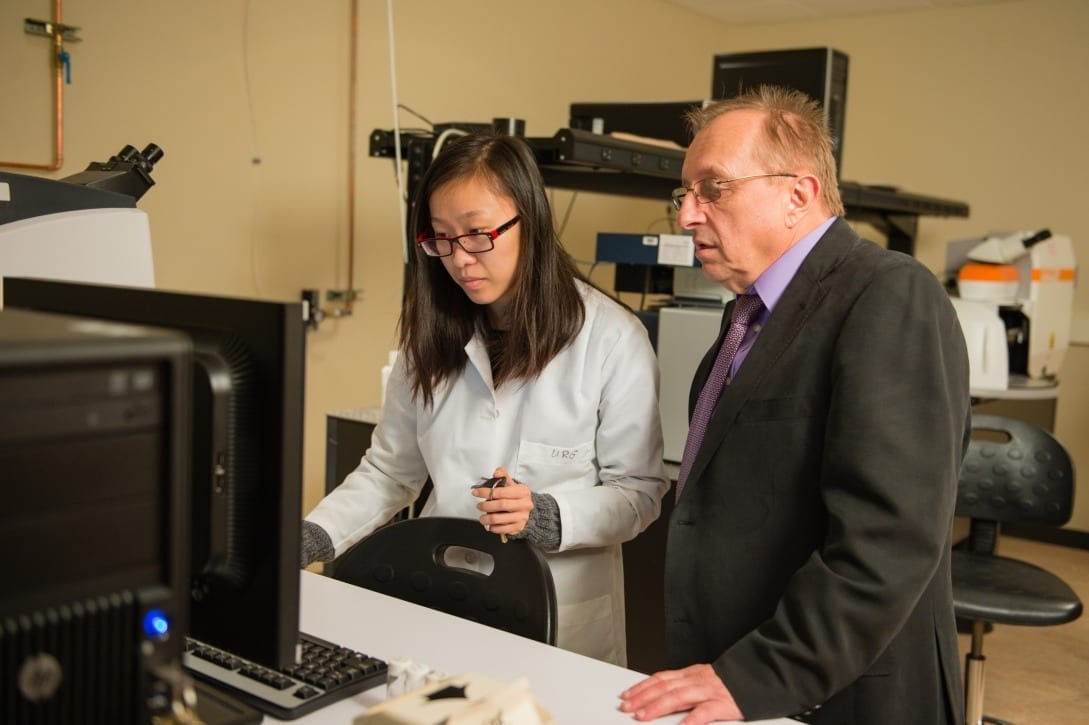
This crystal of iron pyrite shows the characteristic cubic crystals of “fool’s gold.” A new study led by Song Jin at the University of Wisconsin-Madison identifies defects in pyrite’s crystal structure as a critical obstacle to building commercial solar cells from the cheap and abundant iron pyrite material.
As the installation of photovoltaic solar cells continues to accelerate, scientists are looking for inexpensive materials beyond the traditional silicon that can efficiently convert sunlight into electricity.
Theoretically, iron pyrite — a cheap compound that makes a common mineral known as fool’s gold — could do the job, but when it works at all, the conversion efficiency remains frustratingly low. Now, a University of Wisconsin-Madison research team explains why that is, in a discovery that suggests how improvements in this promising material could lead to inexpensive yet efficient solar cells.
“We think we now understand why pyrite hasn’t worked,” says chemistry Professor Song Jin, “and that provides the hope, based on our understanding, for figuring out how to make it work. This could be even more difficult, but exciting and rewarding.”
Although most commercial photovoltaic cells nowadays are based on silicon, the light-collecting film must be relatively thick and pure, which makes the production process costly and energy-intensive, says Jin.
A film of iron pyrite — a compound built of iron and sulfur atoms — could be 1,000 times thinner than silicon and still efficiently absorb sunlight.
Like silicon, iron and sulfur are common elements in the Earth’s crust, so solar cells made of iron pyrite could have a significant material cost advantage in large scale deployment. In fact, previous research that balanced factors like theoretical efficiency, materials availability, and extraction cost put iron pyrite at the top of the list of candidates for low-cost and large-scale photovoltaic materials.
The Latest on: Iron pyrite
[google_news title=”” keyword=”Iron pyrite” num_posts=”10″ blurb_length=”0″ show_thumb=”left”]
via Google News
The Latest on: Iron pyrite
- A First-of-Its-Kind Prehistoric Monument Is Found in Franceon May 7, 2024 at 1:00 am
A team of French archaeologists have discovered a prehistoric monument in the France—one entirely unique to the region.
- Fool's Gold: Looks Like Gold & Used By Fools. But it May Be Important.on April 28, 2024 at 5:00 pm
"Fool's gold" (pyrite) is nice to look at, but not especially useful. That could change if the findings of a small study hold up. Unexpectedly higher levels of lithium – an element that's in enormous ...
- Archaeologists Discovered an ‘Unprecedented’ Ancient Monument That Could Rewrite Historyon April 22, 2024 at 6:00 am
In what the French National Institute for Preventive Archaeological Research (Inrap) is calling an “unprecedented” discovery in Marliens, France, near Dijon, excavations revealed a series of ...
- Researchers point to pyrite as possible source of lithiumon April 15, 2024 at 11:06 pm
A team led by researchers from West Virginia University studied 15 middle-Devonian sedimentary rock samples from the Appalachian basin in the US and found plenty of lithium in pyrite minerals in ...
- Fool's Gold May Be Valuable After All After 'Unheard Of' Discoveryon April 15, 2024 at 7:23 am
Fool's gold or iron pyrite—a common mineral that resembles its precious counterpart—may be more valuable than scientists originally thought, as it has been found to be abundant in lithium.
- Pyrite, also known as fool's gold, may contain valuable lithium, a key element for green energyon April 14, 2024 at 5:00 pm
Scientists say they have found lithium in an unexpected place; fool's gold, or pyrite, deposits. There's a reason airlines won't let you put your laptop in your checked luggage; the lithium-ion ...
- What Chakra Is Pyrite: Meaning, Healing Properties, and Alignmenton December 18, 2023 at 5:12 am
Pyrite, an iron sulfide mineral with high iron content, is excellent for stimulating positive energy. Its name, meaning ‘fire’, reflects its sparkly appearance and fiery energy. With its ...
- Wireless Detectorson May 12, 2023 at 11:25 pm
The Perikon Detector contact is between crystals of chalco-pyrites and zincite; in the Ferron Detector between a crystal of iron pyrites and a metal point; in the Silicon Detector between the ...
via Bing News










